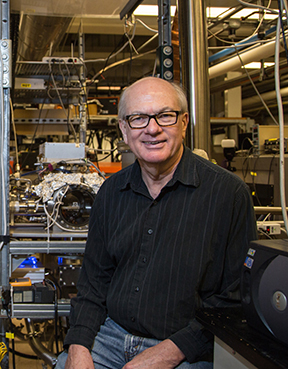This month, four UH Cullen College of Engineering professors earned a four-year grant amounting to almost $1.5 million from the National Science Foundation to pursue their nanopatterning discovery that could lead to next-generation transistors for integrated circuitry, among other advanced nanodevices.
With new capabilities developed through this grant, the researchers can explore potential materials to replace ubiquitous silicon transistor switches, the building blocks of computers that are reaching their technological limitations. Specifically, they are studying the effects of nanopatterning on the scientific super-material, graphene, to invent faster transistors for computers of the future that consume less energy as they operate more quickly.
Several years ago, Vincent Donnelly, principal investigator on this project, and Demetre Economou, both Cullen College chemical and biomolecular engineering professors, along with Paul Ruchhoeft, Cullen College electrical and computer engineering associate professor, invented nanopantography, a novel nanopatterning technique. An array of lenses disperses a broad ion beam into billions of beamlets that each bend to the same spot, approximately 100 times smaller than the diameter of one lens, on a 2-D substrate. The substrate is then tilted so each beamlet can simultaneously etch the desired pattern on its surface.
“In the initial stages of this research, we were able to make features as small as 10 nanometers, which approaches state-of-the-art,” Donnelly said. “More recently, we have reduced features to 3 nanometers, and we believe we can go even smaller, which is something no one has done.”
The lens array was originally fabricated permanently on the substrate, which presented challenges from a long-term manufacturing perspective. Ruchhoeft joined the new project to develop a reusable stencil mask lens array that the engineers can move to cover large substrate surface areas.
The stencil mask is fabricated with posts that secure a 1-micrometer gap between its lens array and the substrate. The positive voltage applied to the lens array for etching also electrostatically clamps the mask to the substrate. Removal of the voltage after processing releases the stencil mask for repeated use on other substrates, the print-and-repeat process.
“We improved the throughput and resolution of this nanopatterning method with a two-step process,” Donnelly said. “Nanopatterns are first formed in a very thin masking layer by nanopantography and then transferred to the underlying material by highly selective plasma etching.”
Donnelly, Economou and Ruchhoeft are collaborating with Jiming Bao, another Cullen College electrical and computer engineering associate professor. Bao joined the project to provide expertise in development of applications for graphene. He intends to explore potential for creating transistor channels from the nanopatterns etched on the highly conductive one-atom-thick carbon sheets. Four doctoral students and several graduate students will also work on the project.
“The proposed work will provide students with rich scientific and educational payoffs,” Donnelly said. “We will also incorporate nanopatterning of 2-D materials into our NSF-seeded, multidisciplinary Nano-Engineering Minor Option, NEMO, a subset of the undergraduate curricula.”
Economou and Donnelly are developing molecular dynamic simulations to follow atomic evolution of the system, primarily the effects of ion bombardment energy on substrate surfaces, to determine the smallest features that exhibit the desired behaviors.
“With this grant, we will develop a unique tool that prints over large areas through the print-and-repeat process, we will demonstrate nanopatterning of graphene sheets and other 2-D materials, and we will measure and characterize these materials,” Ruchhoeft said. “It’s not just a continuation of existing integrated circuit manufacturing approaches since we will have an opportunity to develop new and better performing materials that can displace those currently used.”
